The Huawei Mate 9 Review
by Matt Humrick on January 27, 2017 7:00 AM ESTDisplay
The Mate 9 still uses an FHD (1920x1080) IPS LCD like the Mate 8, but this is an entirely new panel with a different backlight assembly and a small reduction in screen size from 6 inches to 5.9 inches. This is more than just a rounding error: The Mate 9’s screen is definitely smaller, although it’s difficult to notice unless the two phones are sitting side by side. Pixel density increases to 373ppi, up from the Mate 8’s 368ppi, but again this is not really noticeable. While most flagship phones are now using QHD (2560x1440) panels, especially for AMOLED, FHD is still adequate for LCD panels up to around 6 inches due to its greater sub-pixel density relative to PenTile AMOLED panels. There is some loss of sharpness at this size, however. With the Mate 9, it’s possible to see a hint of aliasing on curved edges when specifically looking for it, but this is imperceptible during normal use. The Mate 9’s screen is still very sharp.
Even with a high-quality panel, proper calibration is still necessary, something Huawei has struggled with in the past. Its use of wide-gamut panels and unbalanced RGB settings, which lead to an overly cool white point and screens with an obvious blue tint, hurt color accuracy and negatively impact the user experience. To see if the Mate 9 breaks this trend, we’ll use an X-Rite i1Pro 2 spectrophotometer for color measurements and an i1Display Pro colorimeter for luminance measurements.
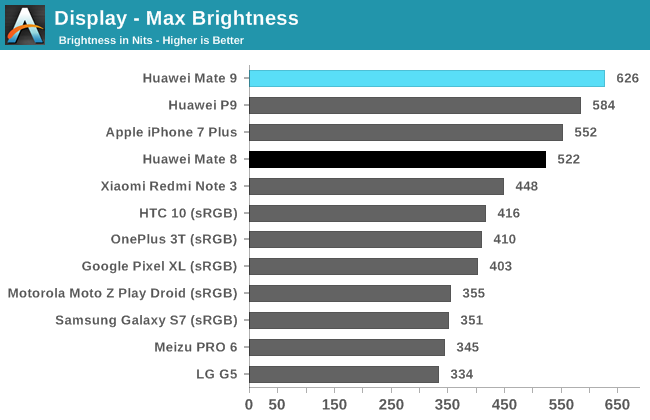
The Mate 9 reaches an impressive 626 nits at peak brightness, about 100 nits more than the Mate 8 and about the same as the iPhone 7 Plus, which hit 618 nits when using its auto-brightness boost (the value in the chart above is for manual mode). It’s even higher than Huawei’s P9 that uses a backlight with 20 LEDs (versus the usual 16 LEDs for a 5-inch class display) to increase peak brightness. And because the Mate 9 does not have an overdrive feature, this peak brightness is available in both manual and auto-brightness modes. Outdoor visibility is quite good, and the display goes down to 4 nits at its lowest setting, making it suitable for use in a dark room.

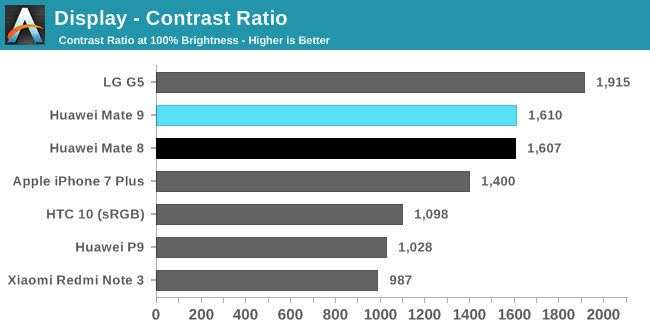
Black level and contrast ratio are measured at maximum brightness, which makes direct black level comparisons more difficult because a display’s black level increases with brightness; however, after normalizing for this effect, the Mate 9’s black level is among the best we’ve tested—equal to the Mate 8 and LG G5, a little better than the iPhone 7 Plus, and noticeably better than the HTC 10. Based on these results, it’s safe to say that the Mate 9’s display uses photo-aligned crystals to improve black level and contrast ratio.
The phones with OLED panels are not shown in these charts because they are able to achieve a black level of zero and a mathematically infinite contrast ratio by being able to completely turn off individual pixels.
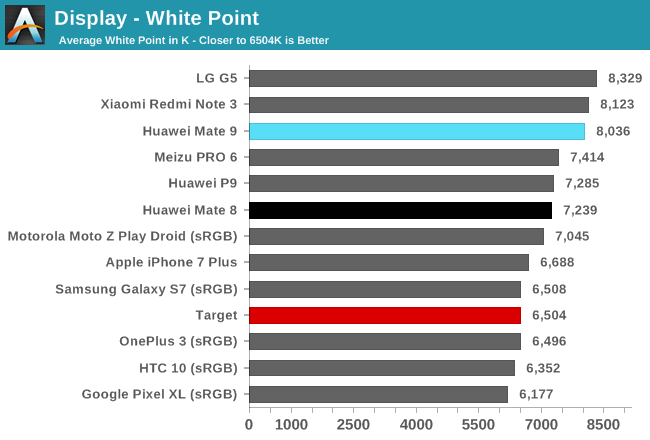
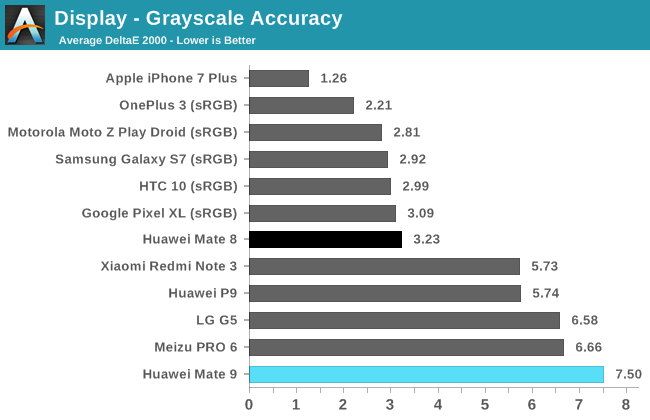
Our grayscale testing shows how Huawei continues to struggle with display calibration. At its “Default” setting, the Mate 9’s white point is over 8,000K, which is even cooler than the Mate 8 and P9. There’s too much emphasis on the blue and green primaries and not enough red, leading to rather poor grayscale accuracy—its ΔE2000 grayscale error is greater than 10 between 75%-100% luminance. This produces a noticeable aqua tint when looking at a white screen.
The Mate 9, like other Huawei phones, offers “Cold” and “Warm” color temperature modes as well as the ability to select a custom white point target by dragging a finger around a color wheel. The Cold setting moves the white point even further from the D65 target value. Increasing the imbalance between blue and red, while reducing the green primary slightly, shifts the hue of the display’s tint from aqua to blue. The name of the Mate 9’s Warm mode is misleading: There’s still too much green and not enough red, giving the screen a mint green tint.
It’s nice that Huawei includes the ability to set a custom white point; however, despite my best efforts, I was unable to get the average CCT to drop below 7,500K or completely correct the RGB imbalance that gives the screen a blue/turquoise/green tint. The best I could do was balance blue and green, while giving a small boost to red, which reduced grayscale error somewhat and made the aqua tint much less noticeable.
Huawei also missed the mark when calibrating the Mate 9’s gamma curve. In general, gamma is a bit too high, leading to a loss of shadow detail and slightly darker images. The gamma curve is not stable over the full luminance sweep either.

Huawei continues to use wide color gamut displays for its flagship phones. The Mate 9’s display extends coverage for reds and greens but the blue primary falls short relative to the sRGB gamut. Android’s lack of color management usually leads to oversaturated colors on wide gamut panels, and the Mate 9 does exhibit this characteristic for most hues once they reach the 50%-60% saturation level; however, the effect is less pronounced at lower saturation levels, where we see greater accuracy. Changing between the different display modes shifts color hues due to changes in white point but does not significantly alter saturation levels. While the Mate 9 does not have an sRGB mode to improve saturation or color accuracy, it manages to have vibrant colors without being overly garish like some wide gamut panels.
To see how the Mate 9 achieves its wider color gamut, I measured the spectral power distribution (SPD) of its backlight with a spectrometer and compared it to the LG G3, which shows the typical signature for a panel that covers around 100% of the sRGB color space. The G3’s sharp peak around 450nm comes from using blue LEDs, while broader, smaller peaks in the green and orange portions of the spectrum are from yellow photoreactive phosphors applied to the LEDs. The wavelengths of light emitted by the backlight combine into what we perceive as white light.
The Mate 9’s SPD shows a sharp peak at 455nm, indicating that it also uses blue LEDs; however, the response in the green and red portions of the spectrum look significantly different. The greater output in these colors, which give the Mate 9 its wider gamut coverage, comes from using red and green phosphors instead of a single yellow phosphor.

Color accuracy in Default mode is better than expected considering the poor grayscale performance and wide gamut display. The Mate 9’s average ΔE2000 error is not great, but most of the tested colors actually fall below 3, the threshold where error is generally considered acceptable. Using the custom setting, whose better RGB balance reduces the error component due to hue shift, drops color error further, with only highly saturated colors showing significant error.
Neither of the two Mate 9’s in our lab show any backlight bleed or issues with luminance uniformity; however, the Mate 9 suffers from the same off-axis viewing issues as the Honor 8. There’s a noticeable white, red-tinted glow that’s plainly visible at angles greater than about 10°-15° that becomes progressively worse at higher angles, eventually washing out blacks completely around 45°. There’s also a series of concentric, rainbow-colored ovals that show up when viewing the screen off-center, which are most visible on a white background, a likely byproduct of stressed birefringence in the cover glass. These rainbows are even more pronounced when viewed through polarized sunglasses. Because you’ll likely be looking at the screen straight on most of the time, these problems are not dealbreakers, but other IPS displays, like those used in the iPhones and other flagships, do not have these issues.
Display performance continues to be an issue with Huawei’s flagship phones. The Mate 9’s display in particular gets very bright and has excellent black levels for an IPS panel. But Huawei’s poor calibration degrades grayscale and color accuracy, and the preconfigured Cold and Warm white point settings only make things worse. Manually setting the white point produces better results, but the Mate 9 still cannot match the accuracy and viewing angles of its peers.


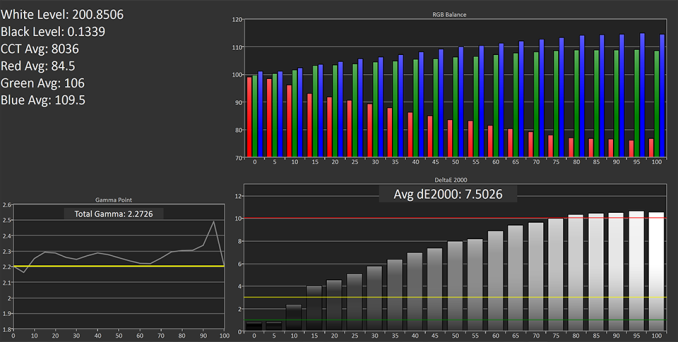

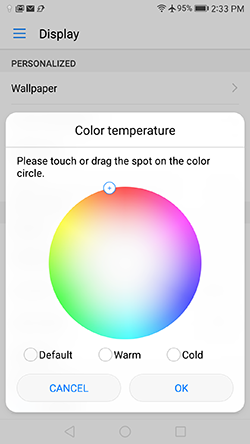

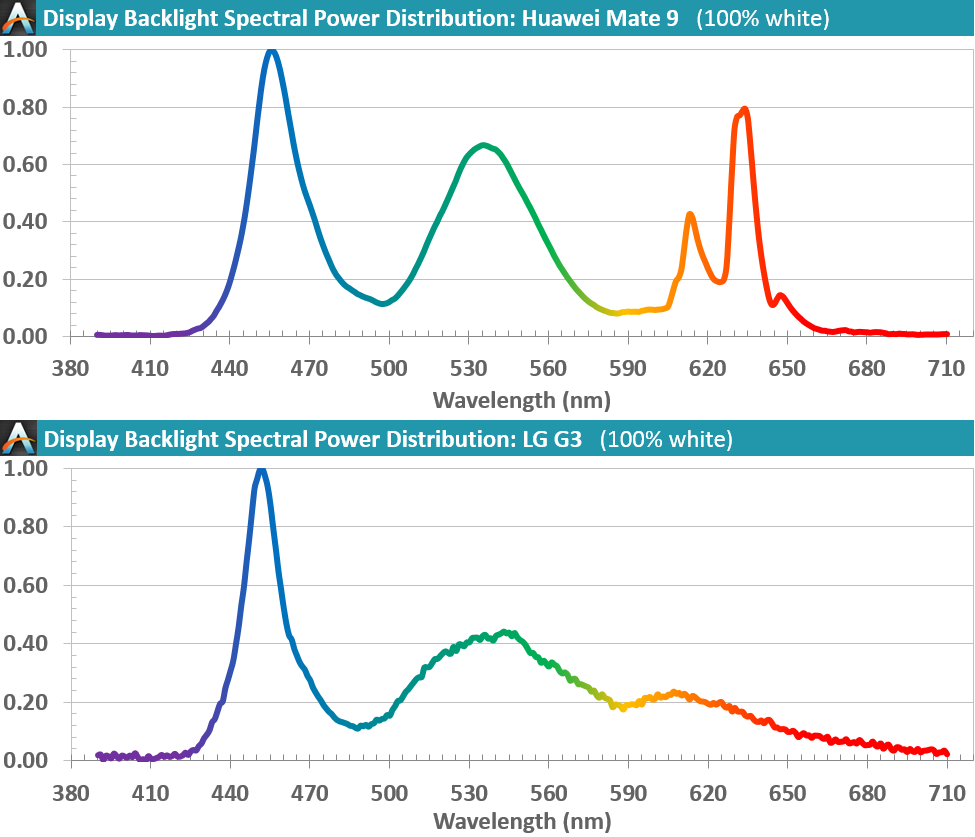










84 Comments
View All Comments
phexac - Tuesday, January 31, 2017 - link
So... a phone at flagship price with sub-par display and jaggy animations. Oh and a brand new processor that can't touch Apple's chips from two years ago. I used to use exclusively Android. Devices such as this is the reason I switched to Apple.TheSmurfboard - Wednesday, February 1, 2017 - link
I have to take issue with the reviewers comments regarding colour balance. In one hand I am reading this on an IpadAir2, the other a Mate9. The whites on the latter certainly looks cooler than the Ipad, but there certainly is no colour cast as implied by the review. I have set the screen to "warm" because it looks better, and so I disagree with the reviewer's remark that this makes it look worse. The reviewer states that there is a red colour cast when the screen is viewed at an angle, but all I notice is a loss of luminescence, about equal to my Ipad. The reviewer states that there are "concentric ovals" seen off-axis, but I can't see them! From casual use I don't see a problem with the colours displayed on this phone, and I really appreciate the "natural" colour rendition of the camera. Also the review doesn't seem to say anything about the potentially awesome 4K video cam, so here's my mini review:This 4K cam produces very detailed well rendered video. I keep exposure compensation permanently at -3, works for me. The optical stabilisation is permanently on, and is rather "fragile", in other words the image quality can abruptly fall apart if subject to vibrations at certain seemingly random frequencies, always hold the cam firmly with both hands, using a tripod is best. The image is also subject to aliasing from geometric patterns like most cams, but I would say its worse than average. Otherwise yes, its awesome!
cmvrgr - Sunday, February 19, 2017 - link
A total disappointment that Mate 9 is NOT - Dual Sim Full Active- like Mate 8. I was ready to order a Mate 9 but after a quick research I bought mate 8 just a couple of days ago for that feature (moved from other brands flagship).Huawei was the only company with that feature that helped them to attract many customers.
If Huawei on Mate 10 will return the DSFA feature back I will stick with Huawei if not I will move to other brands next year as they all are DSDS.
kirenpillay - Thursday, June 22, 2017 - link
I have the Mate 9 and don't seem to see the battery benefits stated in the article. This is my second one, I sent the first one back because my battery didn't last a day, and they replaced it with a new one. The new one behaves the same.My Mate 7 had a better battery life than this one.